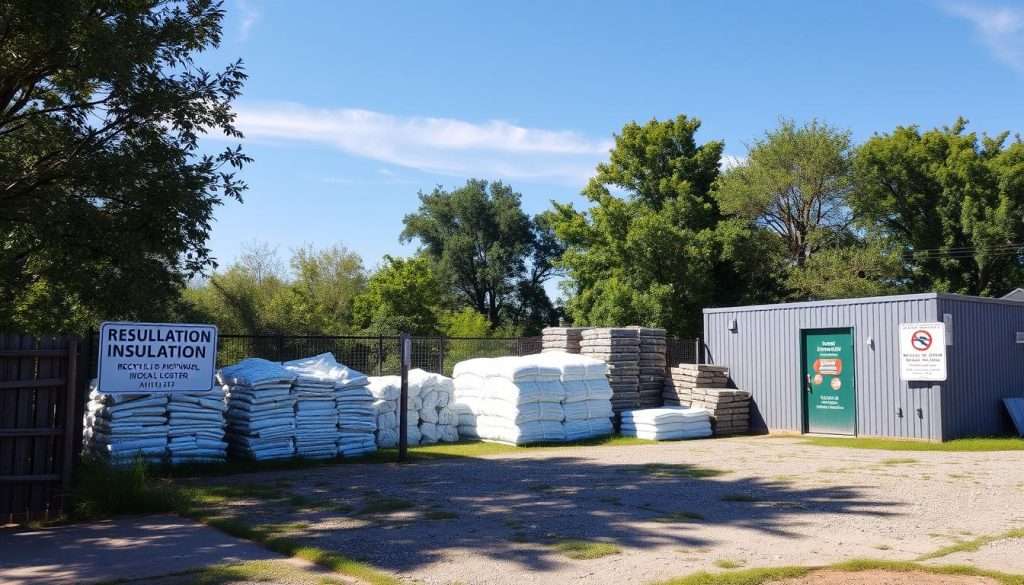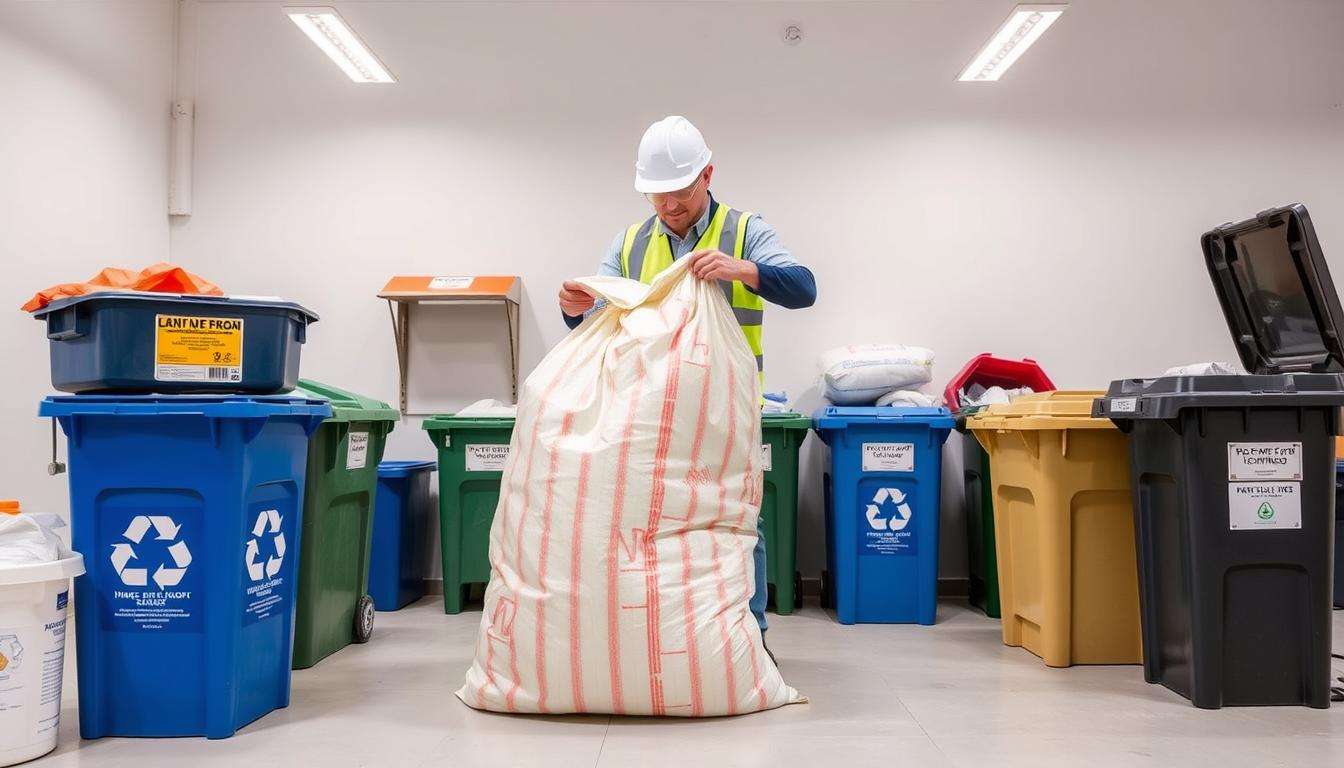Knowing how to get rid of insulation is key. This guide will show you safe ways to remove insulation. It’s important because bad disposal can harm the environment and your home.
It’s crucial to know how to dispose of insulation right. This includes following local rules and staying safe. We’ll cover all you need to know about insulation types and how to get rid of them.
Fiberglass insulation is common in homes. But, not all places can recycle it. Foam board insulation also can’t be recycled because of its fire-safe parts. This guide will help you dispose of insulation safely for a greener future.
Key Takeaways
- Understand the different types of insulation to determine proper disposal methods.
- Fiberglass and mineral wool can often be recycled, but facilities are limited.
- Foam board insulation cannot be recycled due to fire-retardant materials.
- Cellulose insulation, although made from recycled materials, is not recyclable due to added chemicals.
- Professional disposal services might be necessary for certain insulation types, like asbestos.
Understanding Different Types of Insulation
It’s key to know about the different insulation types for proper disposal. Each insulation has its own benefits and disposal needs. This affects how we handle them when they’re no longer needed.
Fiberglass Insulation
Fiberglass is the top choice for home insulation. You’ll find it in ceilings and walls. It’s made from tiny glass fibers, keeping your home warm or cool.
When working with fiberglass, wear protective gear. This helps avoid skin problems and breathing issues.
Foam Board Insulation
Foam insulation is a rigid board, often in basements and attics. It’s made from polystyrene and helps save energy. Cutting tools might be needed for removal, so safety is crucial.
Cellulose Insulation
Cellulose insulation is eco-friendly, made from recycled paper. It’s a loose-fill material that’s effective but has special disposal needs. Removal involves vacuuming or scooping, making sure it’s handled right.
Safety Precautions Before Disposal
Before you start getting rid of insulation, it’s key to know the safety steps. Not following these can harm your health and mess up how you handle things. We’ll talk about the gear you need and why good air flow is important for a safe job.
Protective Gear Needed
When you’re working with insulation, the right gear is a must. Insulation can have bad stuff in it, so you need to protect yourself. Here’s what you should wear:
- Gloves: Keep your hands safe from fibers and irritants.
- Dust Masks: Stop you from breathing in bad particles.
- Goggles: Keep your eyes safe from things that might make them red or sore.
- Long-Sleeve Clothing: Gives extra skin protection from irritants.
These safety steps are key to a safer job. Always put your health first by using the right gear.
Proper Ventilation
Good air flow is super important when you’re removing insulation. A place with fresh air lowers the chance of breathing in bad stuff. Here’s how to make sure the air is good:
- Do the job outside if you can.
- If inside, open windows and doors to let air move.
- Use fans to spread out any air particles.
By following these tips, you make sure you’re working in the best conditions. Good air flow and the right gear help keep you safe from insulation dangers.
Local Regulations for Insulation Disposal
It’s important for homeowners to know about insulation disposal rules in their area. Rules can change based on the insulation type. Many places focus on recycling insulation materials.
Recycling Options
Recycling insulation helps the environment by cutting down on landfill waste. For example, fiberglass insulation can often be recycled. You can contact local waste facilities, insulation makers, or online sites to find recycling spots.
Recycling insulation has many benefits:
- Contributes to environmental conservation by reusing materials.
- It’s a cheaper way than throwing it away.
- It helps make new products, which is good for the planet.
- It helps save natural resources and cuts down on waste.
Landfill Restrictions
Landfills have strict rules for insulation, especially for hazardous materials. Asbestos in insulation, for example, is very dangerous and has strict rules. Safe disposal needs special places.
To avoid fines, always check local rules. Important things to remember include:
- Know what kind of insulation you have to see if it can be recycled.
- Use trusted waste management services.
- Follow safe handling and transport rules for insulation.

How to Remove Insulation Safely
Removing insulation from your home can seem daunting. But with the right tools and knowledge, you can do it well. It’s a chance to make your home more energy-efficient and healthier. To remove insulation safely, you need the right tools and a plan. Here’s what you need to get started.
Tools Required
Before you start, get the tools you need:
- Utility knives for cutting insulation materials
- Dust masks to protect against inhaling particles
- Heavy-duty garbage bags for packaging removed insulation
- Gloves to prevent skin contact with fiberglass fibers
- Safety goggles to shield your eyes from irritation
Step-by-Step Removal Process
Follow this step-by-step guide for safe insulation removal:
- Disconnect any electrical components that may be obstructed by or interacting with the insulation.
- Cut the insulation into manageable sections using utility knives. Be cautious to minimize particles from being released into the air.
- Carefully remove the insulation by bundling it and placing it directly into heavy-duty garbage bags.
- Seal the bags tightly to prevent dust leakage.
- Dispose of the bags according to local regulations or consider recycling options if applicable.
Best Practices for Recycling Insulation
Recycling insulation helps us save the planet. It cuts down on waste and protects our environment. Knowing how to recycle insulation is key to doing it right.
Finding Recycling Centers
First, find places that recycle insulation. Finding recycling centers that take fiberglass insulation is a good start. They might also take mineral wool or other natural fibers. Always check what’s available in your area.
Preparing Insulation for Recycling
Getting insulation ready for recycling is important. Here’s how to do it right:
- Take out the insulation carefully to avoid breaking it.
- Wrap the insulation tightly so it’s easy to carry.
- Mark what kind of insulation it is, especially if it’s mixed or has harmful stuff.
- Look up what the recycling center needs; they might have special rules.
By following these steps, you help the recycling process go smoothly. Recycling insulation saves resources and helps make new products. It’s a big step towards being more eco-friendly.
| Insulation Type | Recyclable? | Common Recycling Center Practices |
|---|---|---|
| Fiberglass Insulation | Yes | Requires specialized facilities, can be recycled into thermal materials |
| Mineral Wool Insulation | Yes | Accepted at many recycling centers |
| Cellulose Insulation | No | Often requires disposal as waste |
| Foam Board Insulation | Varies | Check with local recycling centers for acceptability |
Alternatives to Disposal
Before you throw away insulation, look at other options. Upcycling insulation materials is a creative way to reuse them. You can use them for soundproofing or as thermal barriers.
Upcycling Insulation Materials
Upcycling insulation is good for the planet and keeps materials out of landfills. Here are some ideas:
- Use fiberglass insulation as soundproofing in homes or studios.
- Transform old cellulose insulation into decorative home projects.
- Employ foam board insulation in craft projects or as thermal barriers in various applications.
Local recycling centers can turn old fiberglass insulation into new products. By choosing these alternatives, you help the environment and improve your home.
Donating Usable Insulation
If your insulation is still good, consider donating it. Places like Habitat for Humanity and local charities take donations for community projects. Donating helps families in need and supports green initiatives. For more on how to donate, visit this resource.

Cost of Professional Insulation Disposal Services
Knowing how much professional insulation disposal costs is key for homeowners. Prices change based on several things that can really affect your budget. Knowing what to expect helps make the process smoother.
Factors Influencing Cost
Several things affect the price of insulation disposal:
- Type of Insulation: Different materials last different lengths of time and need different disposal methods. For example, fiberglass can last 80 to 100 years, while cellulose only lasts 20 to 30 years. This affects how much it costs to dispose of it.
- Volume of Insulation: The more insulation you need to remove, the more it costs for labor and disposal.
- Geographical Location: Where you live can change the cost of labor and disposal fees.
- Pest Infestation or Damage: If pests, water, or mold damage the insulation, it may cost more to remove it.
- Access & Equipment: If you need special tools or access, it can cost more.
When to Hire Professionals
Decide when you need insulation removal experts:
- Large-Scale Projects: For big jobs that you can’t do yourself, hiring pros saves time and keeps you safe.
- Dealing with Hazardous Materials: If the insulation is dangerous, like asbestos, you need experts.
- Pest-Infested Insulation: Pros can handle pests and make sure everything is clean and safe.
- Presence of Water or Mold Damage: For big damage, experts know how to fix it and prevent more problems.
DIY Disposal Methods for Insulation
There are many DIY ways to get rid of insulation. These methods are good for the planet and keep you safe. Knowing how to do it right is key.
Safe Burning Practices
Not all insulation can be burned safely. Cellulose insulation, made from recycled paper, is okay to burn. But first, make sure it doesn’t have chemicals that could make bad fumes.
Fiberglass insulation is not safe to burn. It can make you sick and hurt your skin. Always check if you can burn things in your area.
Composting Cellulose Insulation
Composting cellulose insulation is a great choice. It’s made from plants and breaks down easily. This helps the soil and keeps landfills clean.
Make sure the cellulose insulation doesn’t have chemicals. This way, it can turn into good soil for your garden.
| Method | Description | Safety Considerations |
|---|---|---|
| Safe Burning Insulation | Involves burning cellulose insulation materials that are untreated and natural. | Avoid burning fiberglass. Ensure compliance with local regulations. |
| Composting Cellulose Insulation | Recycling cellulose insulation through composting to enrich soil. | Use only untreated cellulose materials. Verify absence of harmful chemicals. |
Using these DIY methods can help manage waste at home. They are good for the planet. Always be careful and follow local rules.
FAQs About Insulation Disposal
When you deal with insulation disposal, you might have many questions. Homeowners often ask about recycling or safely getting rid of insulation. They also worry about following safety rules and local laws.
We’ve gathered important info to help you understand insulation disposal FAQs.
Common Concerns
Many wonder if insulation can be recycled. Some insulation, like cellulose, can be recycled. But fiberglass insulation usually goes in the trash.
It’s also important to wear the right gear, like gloves and masks, when handling insulation. Knowing your local disposal laws is key. Breaking these rules can lead to big fines in many places.
Tips for Homeowners
To manage insulation well, follow these tips. First, check with your local waste services about recycling and collection times. They can tell you what they accept.
If you’re not sure about disposal, think about hiring professionals. They know the rules and how to handle it safely. Also, plan your disposal based on what facilities can take. Some accept special items like mattresses or hazardous waste.
By making smart choices, you’ll make insulation disposal easier.
